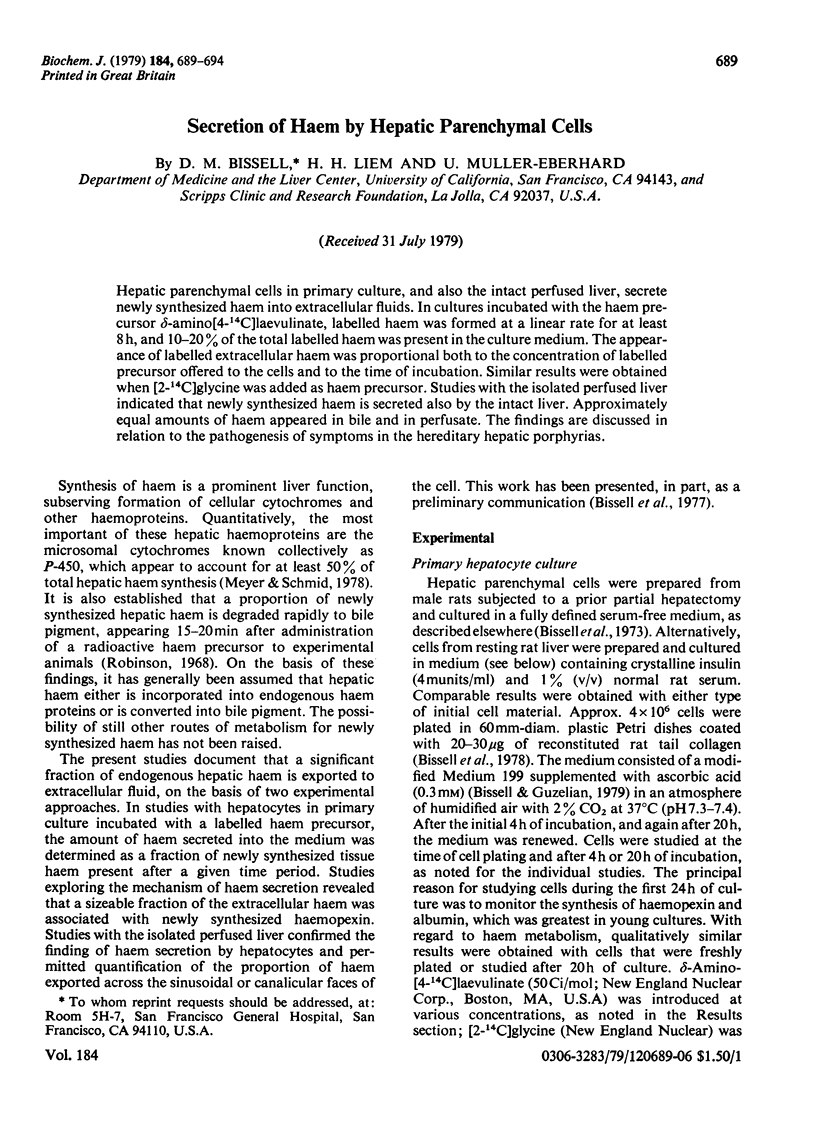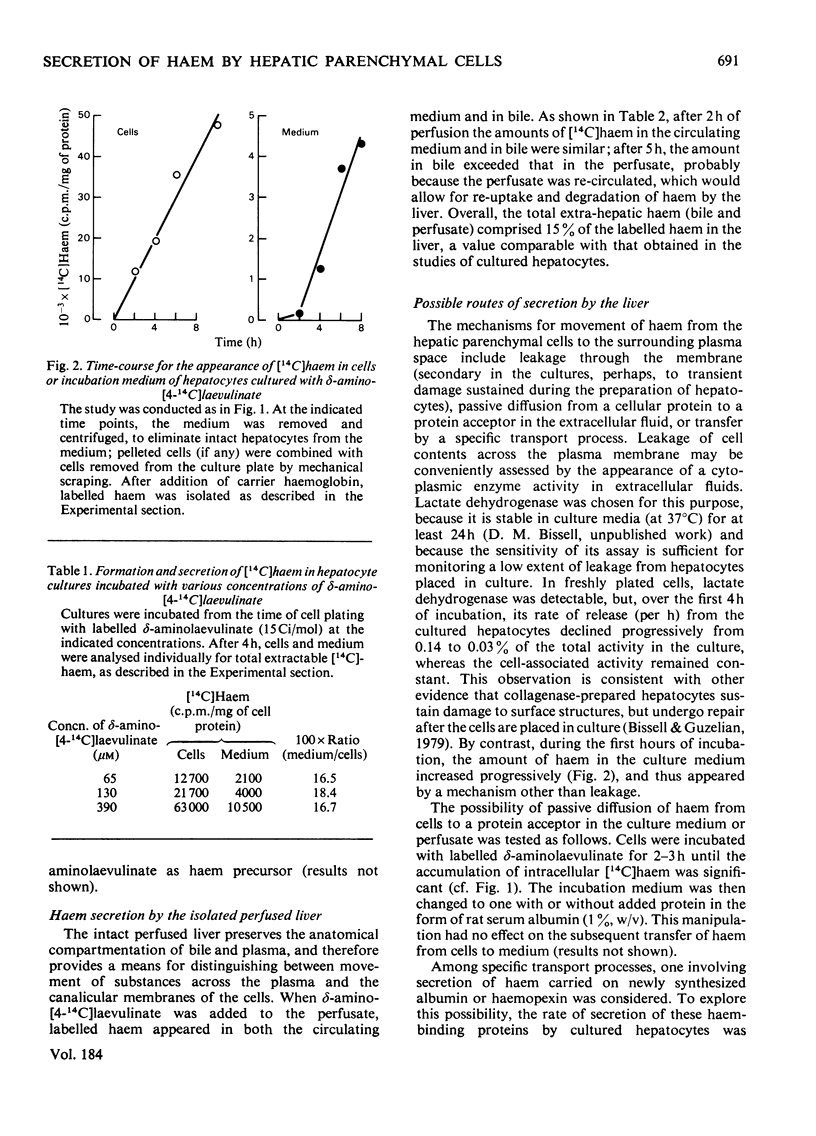Abstract
Hepatic parenchymal cells in primary culture, and also the intact perfused liver, secrete newly synthesized haem into extracellular fluids. In cultures incubated with the haem precursor delta-amino[4-14C]laevulinate, labelled haem was formed at a linear rate for at least 8 h, and 10-20% of the total labelled haem was present in the culture medium. The appearance of labelled extracellular haem was proportional both to the concentration of labelled precursor offered to the cells and to the time of incubation. Similar results were obtained when [2-14C]glycine was added as haem precursor. Studies with the isolated perfused liver indicated that newly synthesized haem is secreted also by the intact liver. Approximately equal amounts of haem appeared in the bile and in perfusate. The findings are discussed in relation to the pathogenesis of symptoms in the hereditary hepatic porphyrias.
Full text
PDF





Selected References
These references are in PubMed. This may not be the complete list of references from this article.
- Bass N. M., Kirsch R. E., Tuff S. A., Saunders S. J. Radioimmunoassay of plasma ligandin: a sensitive index of experimental hepatocellular necrosis. Gastroenterology. 1978 Oct;75(4):589–594. [PubMed] [Google Scholar]
- Bissell D. M., Guzelian P. S. Ascorbic acid deficiency and cytochrome P-450 in adult rat hepatocytes in primary monolayer culture. Arch Biochem Biophys. 1979 Feb;192(2):569–576. doi: 10.1016/0003-9861(79)90127-9. [DOI] [PubMed] [Google Scholar]
- Bissell D. M., Hammaker L. E. Cytochrome P-450 heme and the regulation of hepatic heme oxygenase activity. Arch Biochem Biophys. 1976 Sep;176(1):91–102. doi: 10.1016/0003-9861(76)90144-2. [DOI] [PubMed] [Google Scholar]
- Bissell D. M., Hammaker L. E., Meyer U. A. Parenchymal cells from adult rat liver in nonproliferating monolayer culture. I. Functional studies. J Cell Biol. 1973 Dec;59(3):722–734. doi: 10.1083/jcb.59.3.722. [DOI] [PMC free article] [PubMed] [Google Scholar]
- Bissell D. M., Hammaker L., Schmid R. Hemoglobin and erythrocyte catabolism in rat liver: the separate roles of parenchymal and sinusoidal cells. Blood. 1972 Dec;40(6):812–822. [PubMed] [Google Scholar]
- Bissell D. M., Levine G. A., Bissell M. J. Glucose metabolism by adult hepatocytes in primary culture and by cell lines from rat liver. Am J Physiol. 1978 Mar;234(3):C122–C130. doi: 10.1152/ajpcell.1978.234.3.C122. [DOI] [PubMed] [Google Scholar]
- Bonkowsky H. L., Tschudy D. P., Collins A., Doherty J., Bossenmaier I., Cardinal R., Watson C. J. Repression of the overproduction of porphyrin precursors in acute intermittent porphyria by intravenous infusions of hematin. Proc Natl Acad Sci U S A. 1971 Nov;68(11):2725–2729. doi: 10.1073/pnas.68.11.2725. [DOI] [PMC free article] [PubMed] [Google Scholar]
- Kida Setsuko, Muller-Eberhard U. A radioimmunoassay employing polyethylene glycol (PEG) for measuring dilute concentrations of rat hemopexin, albumin and haptoglobin. Immunochemistry. 1975 Jan;12(1):97–99. doi: 10.1016/0019-2791(75)90056-7. [DOI] [PubMed] [Google Scholar]
- LABBE R. F., NISHIDA G. A new method of hemin isolation. Biochim Biophys Acta. 1957 Nov;26(2):437–437. doi: 10.1016/0006-3002(57)90033-1. [DOI] [PubMed] [Google Scholar]
- LOWRY O. H., ROSEBROUGH N. J., FARR A. L., RANDALL R. J. Protein measurement with the Folin phenol reagent. J Biol Chem. 1951 Nov;193(1):265–275. [PubMed] [Google Scholar]
- Liem H. H., Miyai K., Muller-Eberhard U. Effect of porphyrinogenic agents on protein synthesis and bilirubin formation by the isolated perfused rat liver. Biochim Biophys Acta. 1977 Jan 24;496(1):52–64. doi: 10.1016/0304-4165(77)90114-3. [DOI] [PubMed] [Google Scholar]
- OSTROW J. D., JANDL J. H., SCHMID R. The formation of bilirubin from hemoglobin in vivo. J Clin Invest. 1962 Aug;41:1628–1637. doi: 10.1172/JCI104620. [DOI] [PMC free article] [PubMed] [Google Scholar]
- Robinson S. H. The origins of bilirubin. N Engl J Med. 1968 Jul 18;279(3):143–149. doi: 10.1056/NEJM196807182790306. [DOI] [PubMed] [Google Scholar]
- SNYDER A. L., SCHMID R. THE CONVERSION OF HEMATIN TO BILE PIGMENT IN THE RAT. J Lab Clin Med. 1965 May;65:817–824. [PubMed] [Google Scholar]
- Shanley B. C., Percy V. A., Neethling A. C. Pathogenesis of neural manifestations in acute porphyria. S Afr Med J. 1977 Apr 2;51(14):458–460. [PubMed] [Google Scholar]
- Smith A., Morgan W. T. Transport of heme by hemopexin to the liver: evidence for receptor-mediated uptake. Biochem Biophys Res Commun. 1978 Sep 14;84(1):151–157. doi: 10.1016/0006-291x(78)90276-0. [DOI] [PubMed] [Google Scholar]
- Tipping E., Ketterer B., Christodoulides L., Enderby G. The interactions of haem with ligandin and aminoazo-dye-binding protein A. Biochem J. 1976 Aug 1;157(2):461–467. doi: 10.1042/bj1570461. [DOI] [PMC free article] [PubMed] [Google Scholar]
- Watson C. J., Pierach C. A., Bossenmaier I., Cardinal R. Postulated deficiency of hepatic heme and repair by hematin infusions in the "inducible" hepatic porphyrias. Proc Natl Acad Sci U S A. 1977 May;74(5):2118–2120. doi: 10.1073/pnas.74.5.2118. [DOI] [PMC free article] [PubMed] [Google Scholar]


